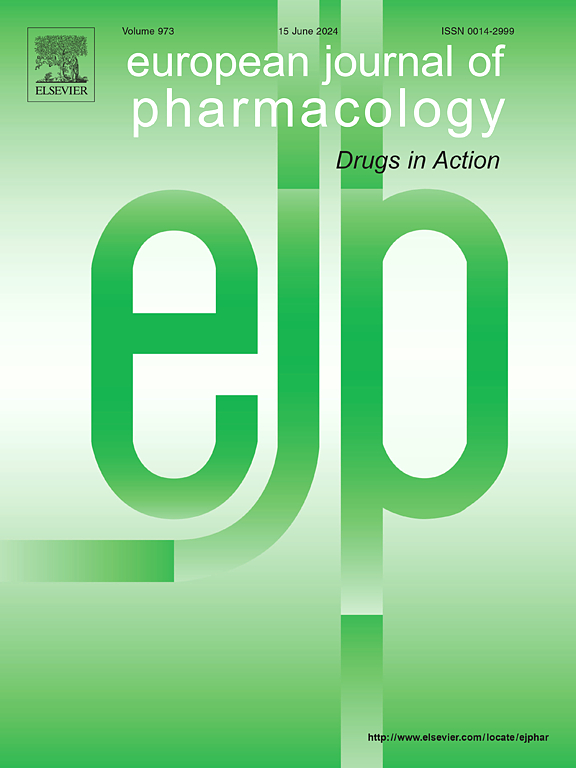轻度结扎性牙周炎大鼠肠系膜抵抗动脉中存在功能失调的可溶性鸟苷酸环化酶
IF 4.2
3区 医学
Q1 PHARMACOLOGY & PHARMACY
引用次数: 0
摘要
牙周炎因其在口腔中的高患病率及其与全身性疾病的关联而引人注目。轻度牙周炎大鼠动脉血管舒缩活性的功能改变,主要是由于可溶性鸟苷酸环化酶(sGC)酶活性降低。本研究旨在探讨轻度牙周炎大鼠肠系膜抵抗动脉(MRA)的功能反应。结扎(L)组和假手术(S)组大鼠的mra血管反应性采用钢丝肌图评估。此外,还分析了抗氧化酶活性、硝化蛋白的存在、环鸟苷单磷酸(cGMP)水平和电子顺磁共振(EPR)光谱。与S组相比,L组的mra显示硝普钠或西地那非的pD2值降低,sGC刺激器Bay 41-2271的Emax值降低。然而,在sGC激活剂Bay 60-2770方面,各组之间没有观察到差异。L组在SNP刺激后,硝基酪氨酸蛋白表达增加,过氧化氢酶活性增强,超氧化物歧化酶活性降低,cGMP含量降低。与S组相比,L组的EPR谱在g 6.00处出现弱峰,证实了sGC血红素-铁(Fe+2)氧化为血红素-Fe+3。在大鼠双侧结痂性牙周炎的早期阶段,由于sGC活性降低和inos来源的NO、超氧阴离子过量产生,或两者兼有,MRA中一氧化氮(NO)-cGMP通路的功能发生变化。本文章由计算机程序翻译,如有差异,请以英文原文为准。

Presence of dysfunctional soluble guanylate cyclase in mesenteric resistance arteries from rats with mild ligature-induced periodontitis
Periodontitis is notable for its high prevalence in the oral cavity and its association with systemic diseases. Functional alterations in vasomotor activity occur in the arteries of rats with mild periodontitis, primarily due to decreased soluble guanylate cyclase (sGC) enzyme activity. This study aims to investigate the functional response of mesenteric resistance arteries (MRA) obtained from rats with mild periodontitis. Vascular reactivity of MRAs from rats in the ligature (L) or sham (S) groups was assessed using a wire myograph. Additionally, antioxidant enzyme activity, the presence of nitrated proteins, cyclic guanosine monophosphate (cGMP) levels, and electron paramagnetic resonance (EPR) spectroscopy were analyzed. The MRAs from the L group showed lower pD2 values in response to sodium nitroprusside or sildenafil and decreased Emax to the sGC stimulator Bay 41–2271 compared to the S group. However, no differences were observed between the groups with respect to the sGC activator Bay 60–2770. The L group exhibited increased nitrotyrosine protein expression, enhanced catalase activity, and reduced superoxide dismutase activity, along with decreased cGMP content after SNP stimulation. The EPR spectrum of the L group showed a weak peak at g 6.00, compared to the S group, confirming the oxidation of sGC heme-iron (Fe+2) to heme-Fe+3. In the early phase of bilateral ligature-induced periodontitis in rats, functional changes in the nitric oxide (NO)-cGMP pathway occur in the MRA due to reduced sGC activity and excessive production of iNOS-derived NO, superoxide anion, or a combination of both.
求助全文
通过发布文献求助,成功后即可免费获取论文全文。
去求助
来源期刊
CiteScore
9.00
自引率
0.00%
发文量
572
审稿时长
34 days
期刊介绍:
The European Journal of Pharmacology publishes research papers covering all aspects of experimental pharmacology with focus on the mechanism of action of structurally identified compounds affecting biological systems.
The scope includes:
Behavioural pharmacology
Neuropharmacology and analgesia
Cardiovascular pharmacology
Pulmonary, gastrointestinal and urogenital pharmacology
Endocrine pharmacology
Immunopharmacology and inflammation
Molecular and cellular pharmacology
Regenerative pharmacology
Biologicals and biotherapeutics
Translational pharmacology
Nutriceutical pharmacology.

 求助内容:
求助内容: 应助结果提醒方式:
应助结果提醒方式:


